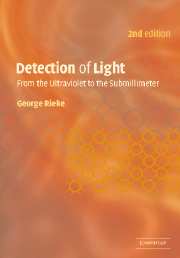Book contents
- Frontmatter
- Contents
- Preface
- 1 Introduction
- 2 Intrinsic photoconductors
- 3 Extrinsic photoconductors
- 4 Photodiodes and other junction-based detectors
- 5 Amplifiers and readouts
- 6 Arrays
- 7 Photoemissive detectors
- 8 Photography
- 9 Bolometers and other thermal detectors
- 10 Visible and infrared coherent receivers
- 11 Submillimeter- and millimeter-wave heterodyne receivers
- 12 Summary
- Appendices
- References
- Index
8 - Photography
Published online by Cambridge University Press: 09 November 2009
- Frontmatter
- Contents
- Preface
- 1 Introduction
- 2 Intrinsic photoconductors
- 3 Extrinsic photoconductors
- 4 Photodiodes and other junction-based detectors
- 5 Amplifiers and readouts
- 6 Arrays
- 7 Photoemissive detectors
- 8 Photography
- 9 Bolometers and other thermal detectors
- 10 Visible and infrared coherent receivers
- 11 Submillimeter- and millimeter-wave heterodyne receivers
- 12 Summary
- Appendices
- References
- Index
Summary
Photography is based on chemical changes that are initiated by the creation of a conduction electron when a photon is absorbed in certain kinds of semiconductor. These changes are amplified by chemical processing until a visible image of the illumination pattern has been produced. Compared with other modern detectors, the quantum efficiency achievable with photography is low, about 1–5%. Photography also suffers from comparatively poor linearity and, in some applications, limited dynamic range. It remains, however, the leader in pixel quantity; an 8 by 10 inch (200 × 250 mm) plate can have 1011-1012 grains, providing some 109 potential picture elements. In addition, photographic materials are inexpensive, provide efficient information storage, and, if treated appropriately, are stable for long periods of time. For these reasons, photography has often been the best detection method in the X-ray, ultraviolet, visible, and very near infrared spectral regions, in spite of the performance improvements attained by individual pixels in electronic detectors. Despite increasing application of electronic detectors, photography remains in wide use. In addition, as virtually the only detector array type for many years, a thorough description of photography is warranted to understand many historical measurements.
Basic operation
Photography was invented and developed through a long series of experiments before solid state physics was understood (as described by Newhall 1983).
- Type
- Chapter
- Information
- Detection of LightFrom the Ultraviolet to the Submillimeter, pp. 217 - 237Publisher: Cambridge University PressPrint publication year: 2002



